An Intelligence Method for Recognizing Multiple Defects in Rail
Abstract
:1. Introduction
2. Materials and Methods
2.1. Signal Dividing
2.2. Principal Component Analysis
- Construct a sample set X of the rail damage characteristics. Matrix A is composed of guided wave detection signals of different defect types or the same type of defects with different levels of damage. As shown in Equation (2), m is the number of detection signals, and n is the number of features in each sample; represents the mth detected signal sample with n data, and represents the first data in the mth sample.The set of samples X of the rail damage characteristic is obtained after centralized processing A. The centralization is expressed in Equation (3), which represents the average value of each column in A.
- Construct the damage covariance matrix C. The correlation coefficient in guided wave detection signals can be used to characterize different defects. A covariance matrix is an efficient tool for characterizing the correlation coefficient. The covariance matrix C is described by Equation (4).
- Calculate the eigenvalues and eigenvectors of the damage covariance matrix C. According to the matrix decomposition method, the eigenvalues and corresponding eigenvectors of matrix C are solved. Then the eigenvalues are ranked in descending order, , and the corresponding eigenvectors in sequential order, . Among them, each eigenvector represents a principal component.
- Determine the number of principal components K. The information percentage of a principal component is an important reference when the number of principal components is determined. The ratio of one eigenvalue to the sum of all eigenvalues is the information percentage of this principal component, as shown in Equation (5).Set a threshold θ (0 < θ < 1) and accumulate the information percentages of the principal components sorted in sequence. When the cumulative sum of the information percentages of the Kth principal component is greater than or equal to θ, there is selected for the K principal components.
- Extract features. The K principal components extracted from the covariance matrix C are gathered to form a local weight matrix W. The process of feature extraction is shown as Equation (7), where X’ is a feature set extracted.
2.3. Build S-PCA
2.4. SVM Classification Model
2.5. Classification Model Evaluation
3. Experimental Setup
3.1. Experimental Setup
3.2. Numerical Simulation
4. Feature Extraction
4.1. Signal Analysis
4.2. Feature Extraction
5. Model Parameter Adjustment
6. Experiment Results and Discuss
6.1. Influence of Tc on the Defect Recognition
6.2. Influence of θP on The Rail Defects Identification
6.3. Influence of θ on the Rail Defect Identification
6.4. Classification Result of Single-Channel Acquisition Signal
6.5. Classification Result of Multi-Channel Signal Combination
7. Conclusions
- The method of extracting features from the segments of detection signal by PCA can effectively eliminate redundant information in the signal and retain adequate information, which improves the accuracy of quantitative and qualitative identification of rail defects.
- The detection signals collected from different excitation-reception positions describe the overall health of the different parts of the rail. Obtaining the combined detection signal through single-point excitation and multi-point reception or multi-point excitation and single-point reception can more comprehensively describe the health status of the detection object, which is good to improve the accuracy of defect recognition.
- The S-PCA algorithm is an efficient method of extracting features based on statistical theory. It does not rely too much on the professional knowledge of guided wave detection, which reduces the difficulty of rail defect identification. Furthermore, the method could be more easily implemented in practical engineering in the future.
Author Contributions
Funding
Institutional Review Board Statement
Informed Consent Statement
Data Availability Statement
Acknowledgments
Conflicts of Interest
References
- Tian, G.Y.; Gao, B.; Gao, Y.L.; Wang, P.; Wang, H.T.; Shi, Y.S. Summary of inspection and monitoring technology for railway rail defects and damage. Chin. J. Sci. Instrum. 2016, 37, 1763–1780. [Google Scholar]
- Hernandez, F.C.; Plascencia, G.; Koch, K. Rail base corrosion problem for North American transit systems. Eng. Fail. Anal. 2009, 16, 281–294. [Google Scholar] [CrossRef]
- Zerbst, U.; Lundén, R.; Edel, K.O.; Smith, R.A. Introduction to the damage tolerance behaviour of railway rails—A review. Eng. Fract. Mech. 2009, 76, 2563–2601. [Google Scholar] [CrossRef] [Green Version]
- Karahaliou, A. Evaluation of Railway Rails with Non-Destructive Techniques. Key Eng. Mater. 2014, 605, 641–644. [Google Scholar] [CrossRef]
- Zhang, H.; Song, Y.N.; Wang, Y.N.; Liang, Z.C.; Zhao, M. Summary of non-destructive testing and evaluation technology for rail defects. Chin. J. Sci. Instrum. 2019, 40, 11–25. [Google Scholar]
- He, C.F.; Zheng, M.F.; Lv, Y.; Deng, P.; Zhao, H.M.; Liu, X.C.; Song, G.R.; Liu, Z.H.; Jiao, J.P.; Wu, B. Development, Application and Challenge of ultrasonic guided wave detection technology. Chin. J. Sci. Instrum. 2016, 37, 1713–1735. [Google Scholar]
- He, C.F.; Wu, B.; Fan, J.W. Research progress and application of ultrasonic cylindrical guided wave technology. Adv. Mech. 2001, 2, 203–214. [Google Scholar]
- Rose, J.L.; Avioli, M.J.; Mudge, P.; Sanderson, R. Guided wave inspection potential of defects in rail. NDT E Int. 2003, 37, 153–161. [Google Scholar] [CrossRef]
- Lu, C.; Sheng, H.J.; Song, K.; Lin, J.M.; He, F.C. Scattering characteristics of ultrasonic guided waves of oblique cracks at the bottom of rails. Non-Destr. Test. 2016, 38, 18–22, 25. [Google Scholar]
- Loveday, P.W. Guided Wave Inspection and Monitoring of Railway Track. J. Nondestruct. Eval. 2012, 31, 303–309. [Google Scholar] [CrossRef]
- Evans, M.; Lucas, A.; Ingram, I. The inspection of level crossing rails using guided waves. Constr. Build. Mater. 2018, 179, 614–618. [Google Scholar] [CrossRef]
- Lee, C.; Joseph, L.; Younho, C. A guided wave approach to defect detection under shelling in rail. NDT E Int. 2009, 42, 174–180. [Google Scholar] [CrossRef]
- Xing, B.; Yu, Z.; Xu, X.; Zhu, L.; Shi, H. Mode Selection Model for Rail Crack Detection Based on Ultrasonic Guided Waves. Shock Vib. 2020, 2020, 19. [Google Scholar] [CrossRef]
- Chen, R.; Hu, C.; Xu, J.; Gong, Z.; Liu, L.; Wang, P.; Chen, X. Research on guided wave propagation characteristics in turnout rails with variable cross-section. J. Sound Vib. 2021, 494, 115853. [Google Scholar] [CrossRef]
- Deng, F.; Chen, H.L. A Defects localization Algorithm Based on the Lamb Wave of Plate Structure. J. Nondestruct. Eval. Diagn. Progn. Eng. Syst. 2021, 4, 021001. [Google Scholar] [CrossRef]
- Liu, X.; Liu, Z.Q. Research on the inverse problem of ultrasonic nondestructive testing. Non-Destr. Test. 2001, 10, 441–443. [Google Scholar]
- Wu, B.; Deng, F.; He, C.F. The research progress of signal processing in ultrasonic guided wave nondestructive testing. J. Beijing Univ. Technol. 2007, 4, 342–348. [Google Scholar]
- Zhou, J.M.; Xu, Q.Y.; Li, P.; Wan, Q.; Liao, X.S. Ultrasonic guided wave technology in nondestructive testing of rails. Instrum. Technol. Sens. 2015, 6, 99–102, 106. [Google Scholar]
- Moustakidis, S.; Kappatos, V.; Karlsson, P.; Selcuk, C.; Gan, T.H.; Hrissagis, K. An Intelligent Methodology for Railways Monitoring Using Ultrasonic Guided Waves. J. Nondestruct. Eval. 2014, 33, 694–710. [Google Scholar] [CrossRef]
- Jiang, Y.; Wang, H.; Tian, G.Y.; Yi, Q.J.; Zhao, J.Y.; Zhen, K. Fast classification for rail defect depths using a hybrid intelligent method. Optik 2019, 180, 455–468. [Google Scholar] [CrossRef]
- Zhou, C.; Deng, F.; Liu, Y.; Liu, X.C.; Cheng, H.L. Research on Identification of Corrosion Damage Degree of Guided Wave Bend Pipe Based on Neural Network and Support Vector Machine. J. Mech. Eng. 2021, 57, 136–144. [Google Scholar]
- Li, S.Q.; Deng, F.; Zhou, C.; Zhang, X.R. Identification of rail crack defects based on support vector machine and artificial neural network. In Proceedings of the 15th Symposium on Piezoelectricity, Acoustic Waves and Device Applications, SPAWDA 2020, Zhengzhou, China, 16–19 April 2021. [Google Scholar]
- Torkamani, S.; Roy, S.; Barkey, M.; Sazonov, E.; Burkett, S.; Kotru, S. A novel damage index for damage identification using guided waves with application in laminated composites. Smart Mater. Struct. 2014, 23, 095015. [Google Scholar] [CrossRef]
- Luca, D.; Fenza, A.; Petrone, G.; Caputo, F. Guided wave SHM system for damage detection in complex composite. Struct. Theor. Appl. Fract. Mech. 2020, 105, 102408. [Google Scholar] [CrossRef]
- Gottumukkal, R.; Asari, V.K. An improved face recognition technique based on modular PCA approach. Pattern Recognit. Lett. 2004, 25, 429–436. [Google Scholar] [CrossRef]
- Senneville, D.B.; El Hamidi, A.; Moonen, C. A direct PCA-based approach for real-time description of physiological organ deformations. IEEE Trans. Med. Imaging 2015, 34, 974–982. [Google Scholar] [CrossRef]
- Mazzeo, P.L.; Nitti, M.; Stella, E.; Distante, A. Visual recognition of fastening bolts for railroad maintenance. Pattern Recognit. Lett. 2004, 25, 669–677. [Google Scholar] [CrossRef]
- Wang, Z.Y.; Zhu, D.H. An accurate detection method for surface defects of complex components based on support vector machine and spreading algorithm. Measurement 2019, 147, 106886. [Google Scholar] [CrossRef]
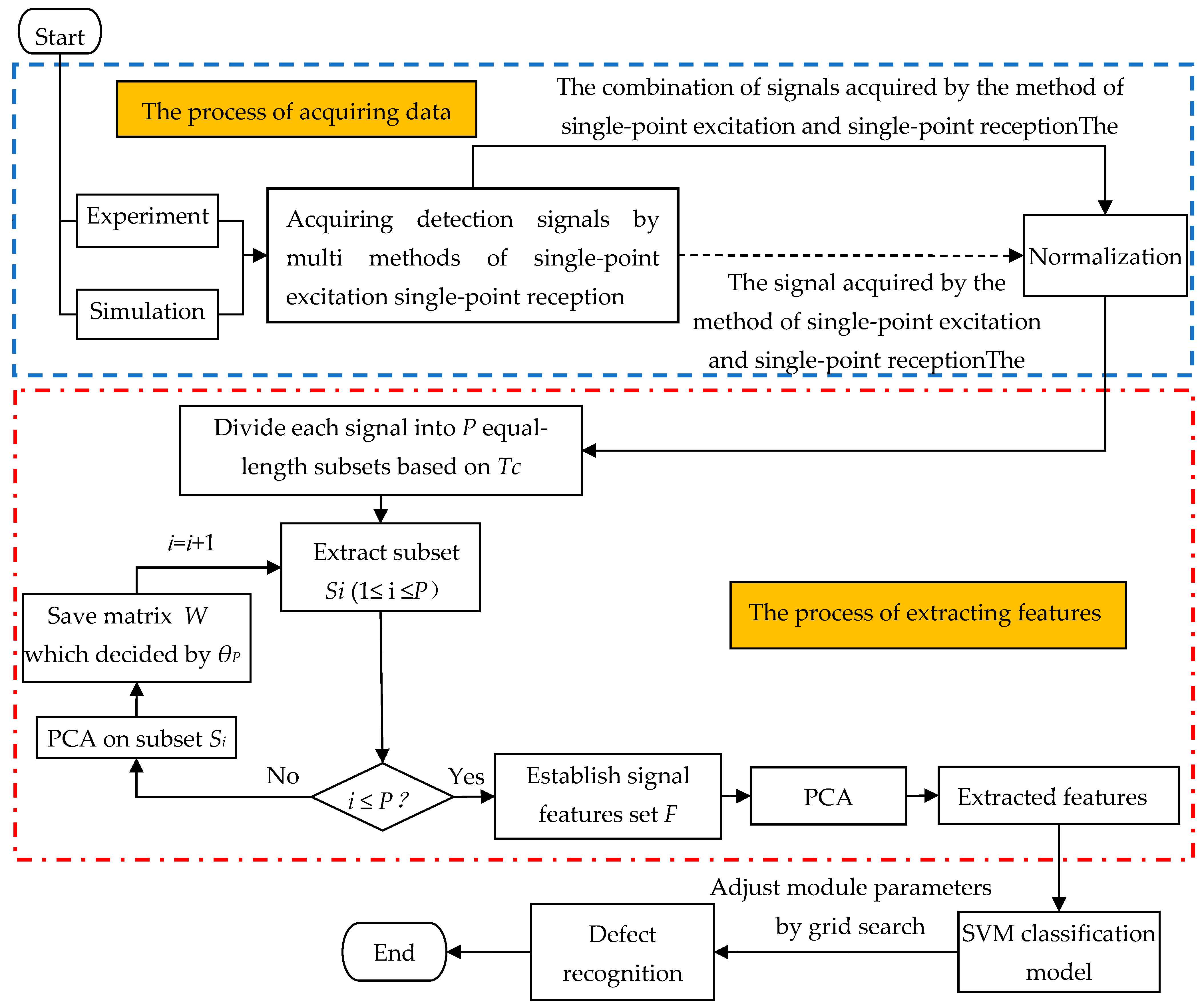
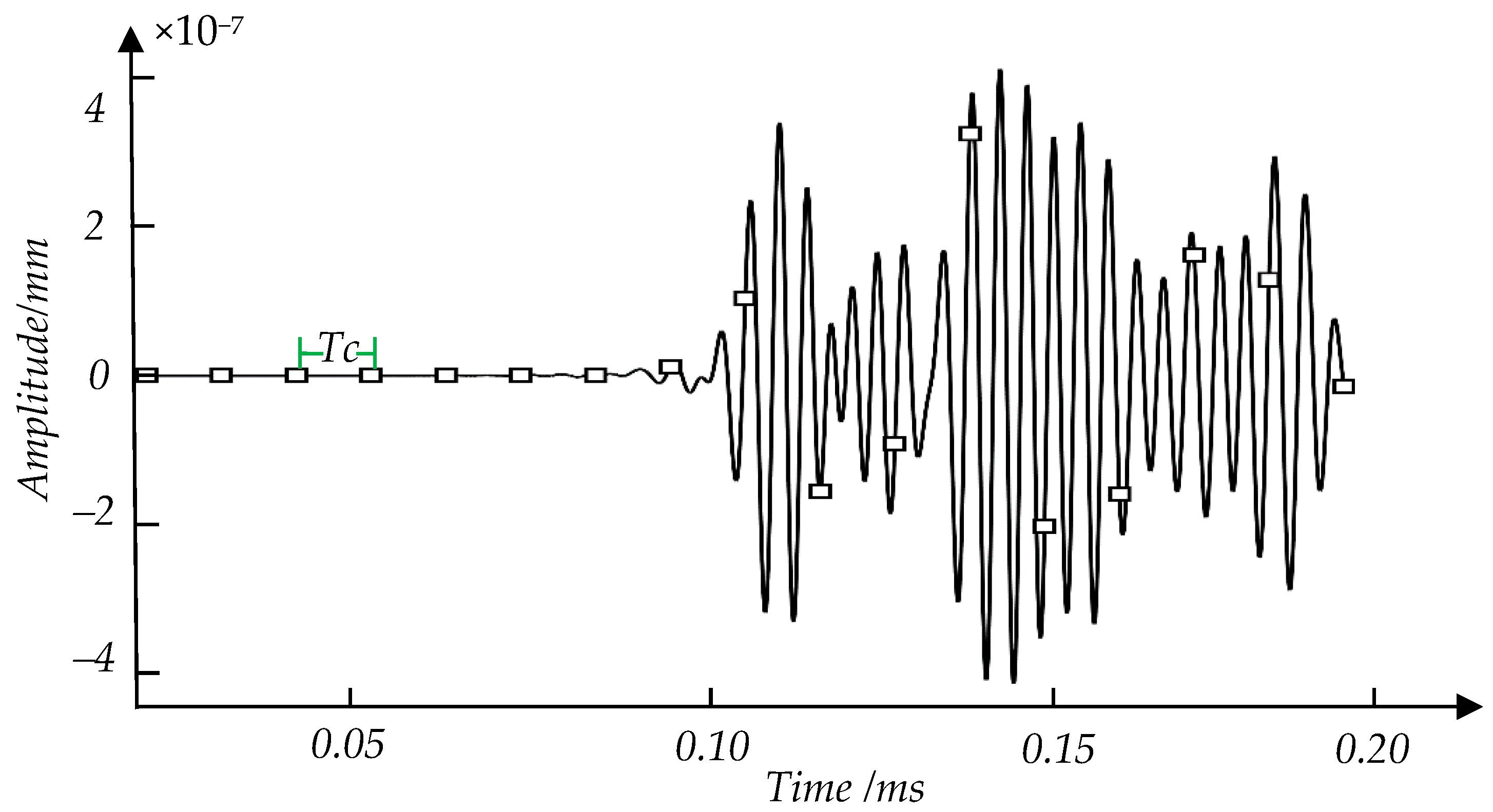
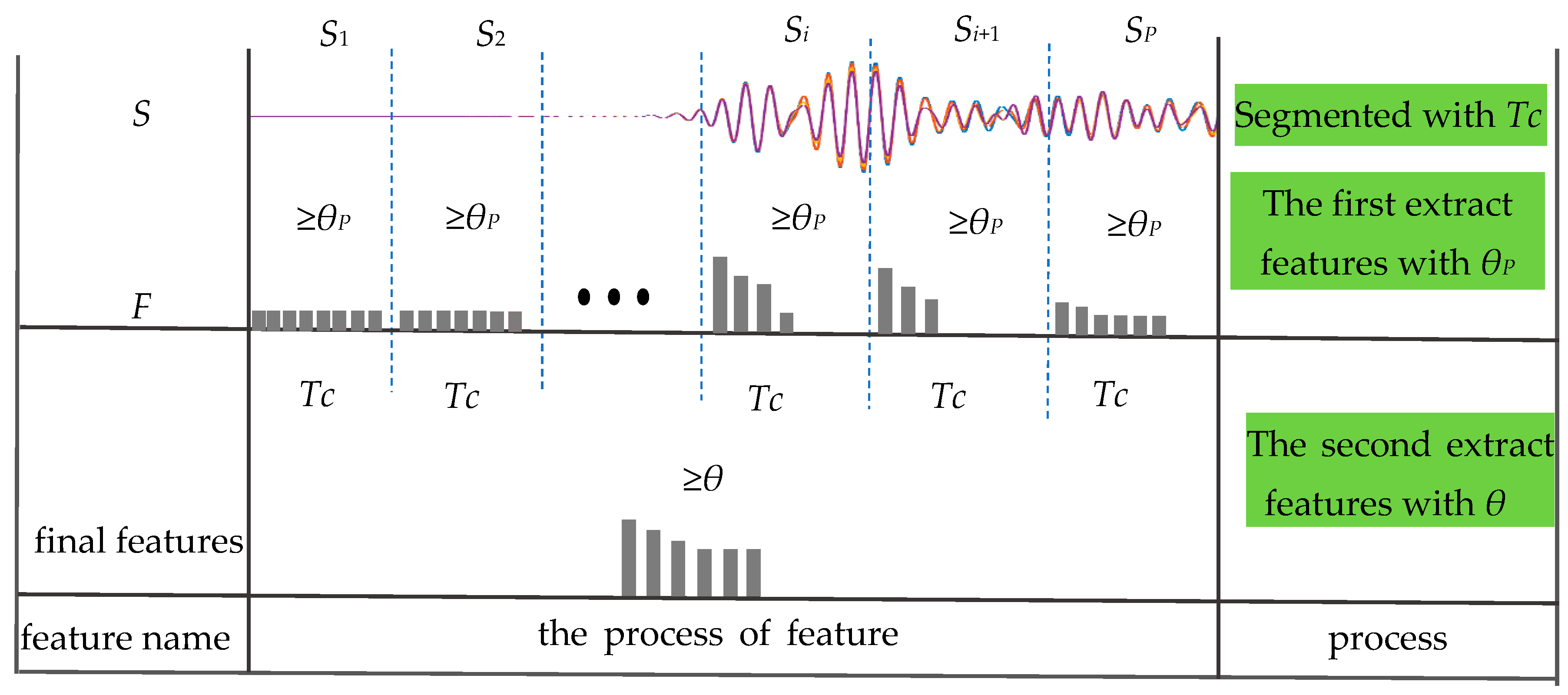

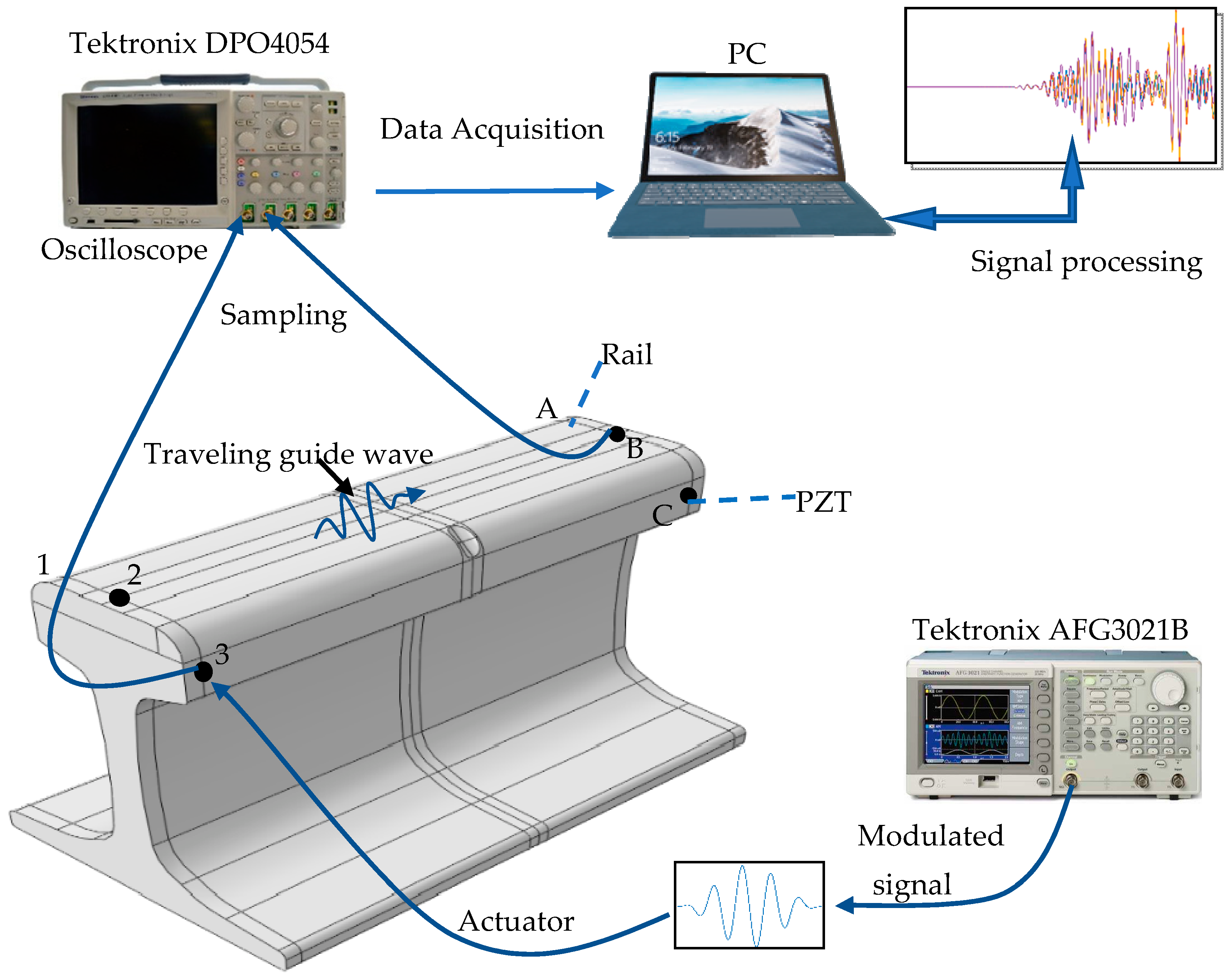

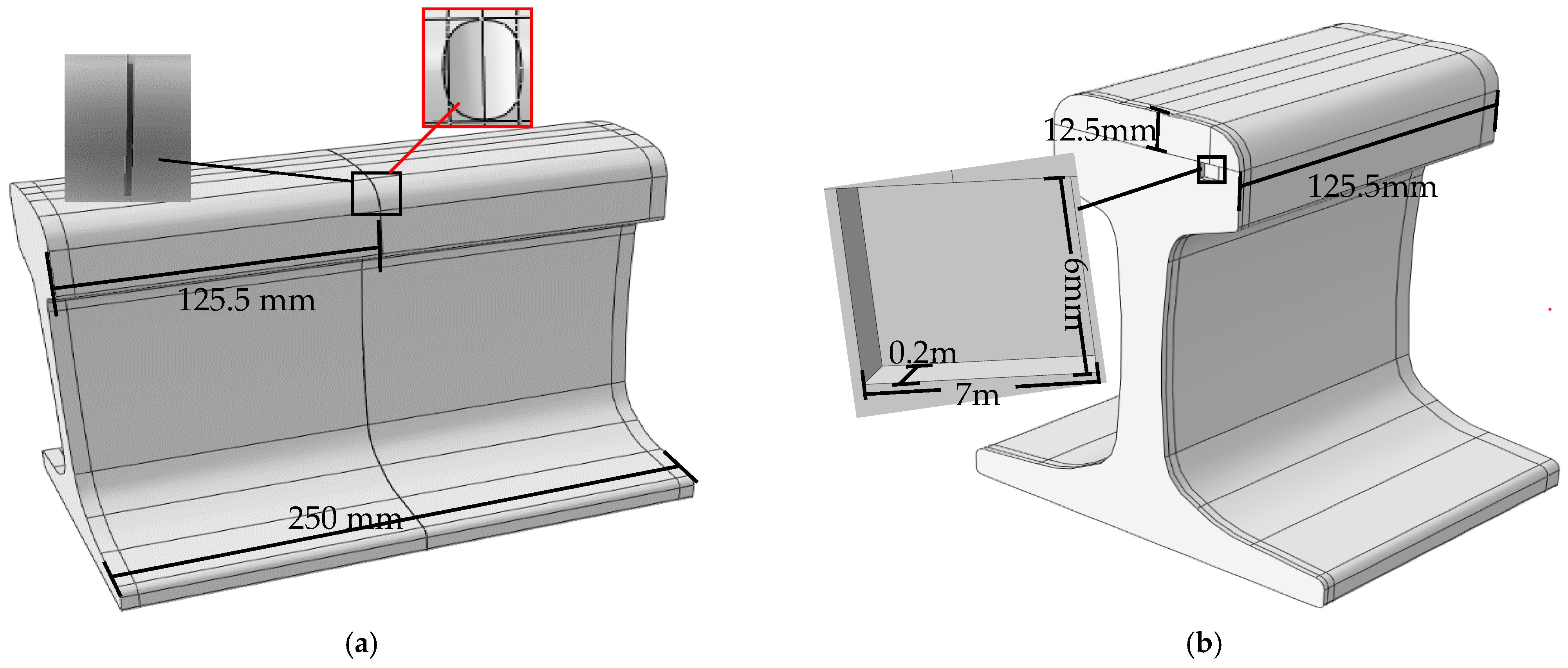
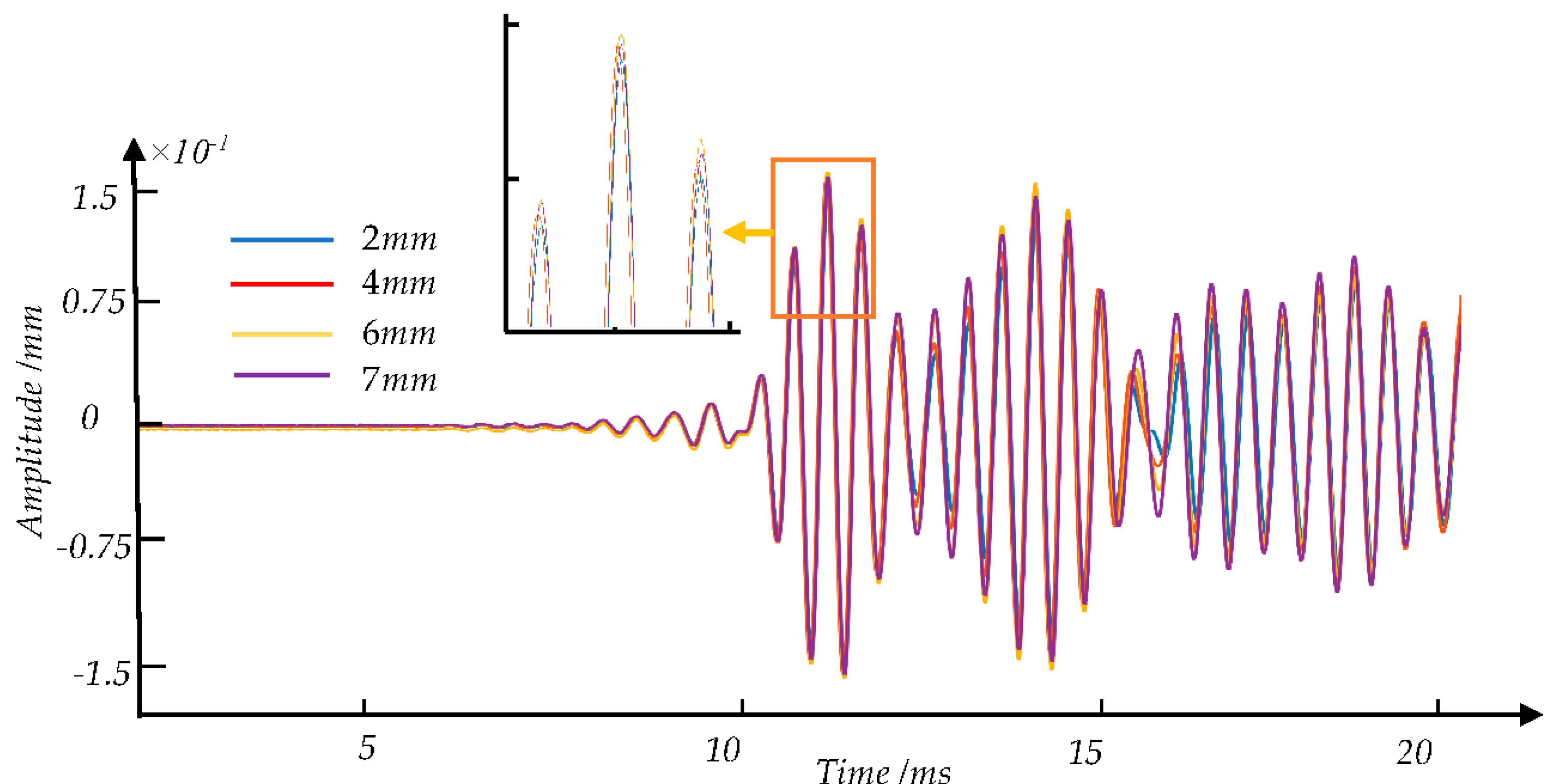
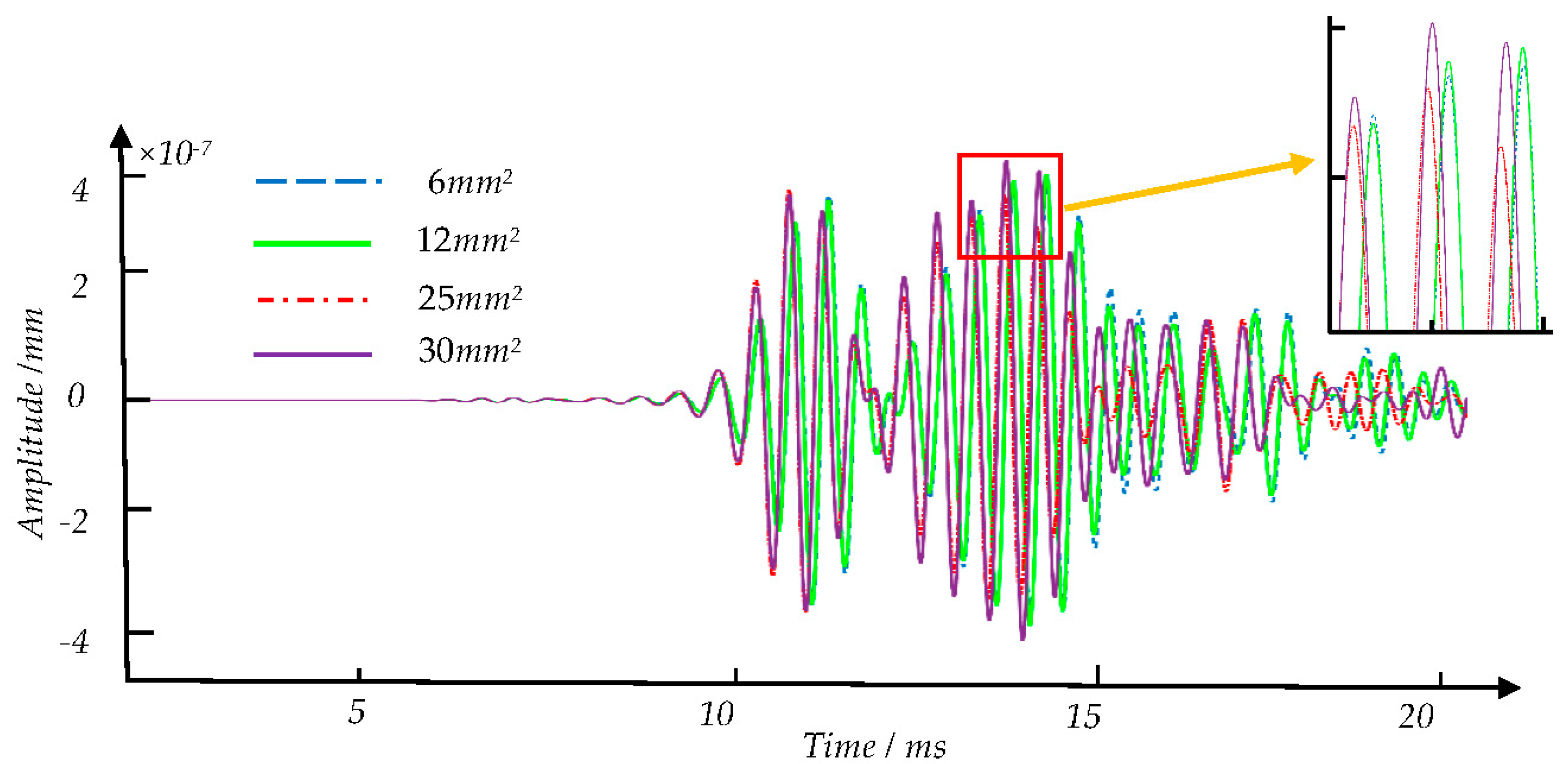
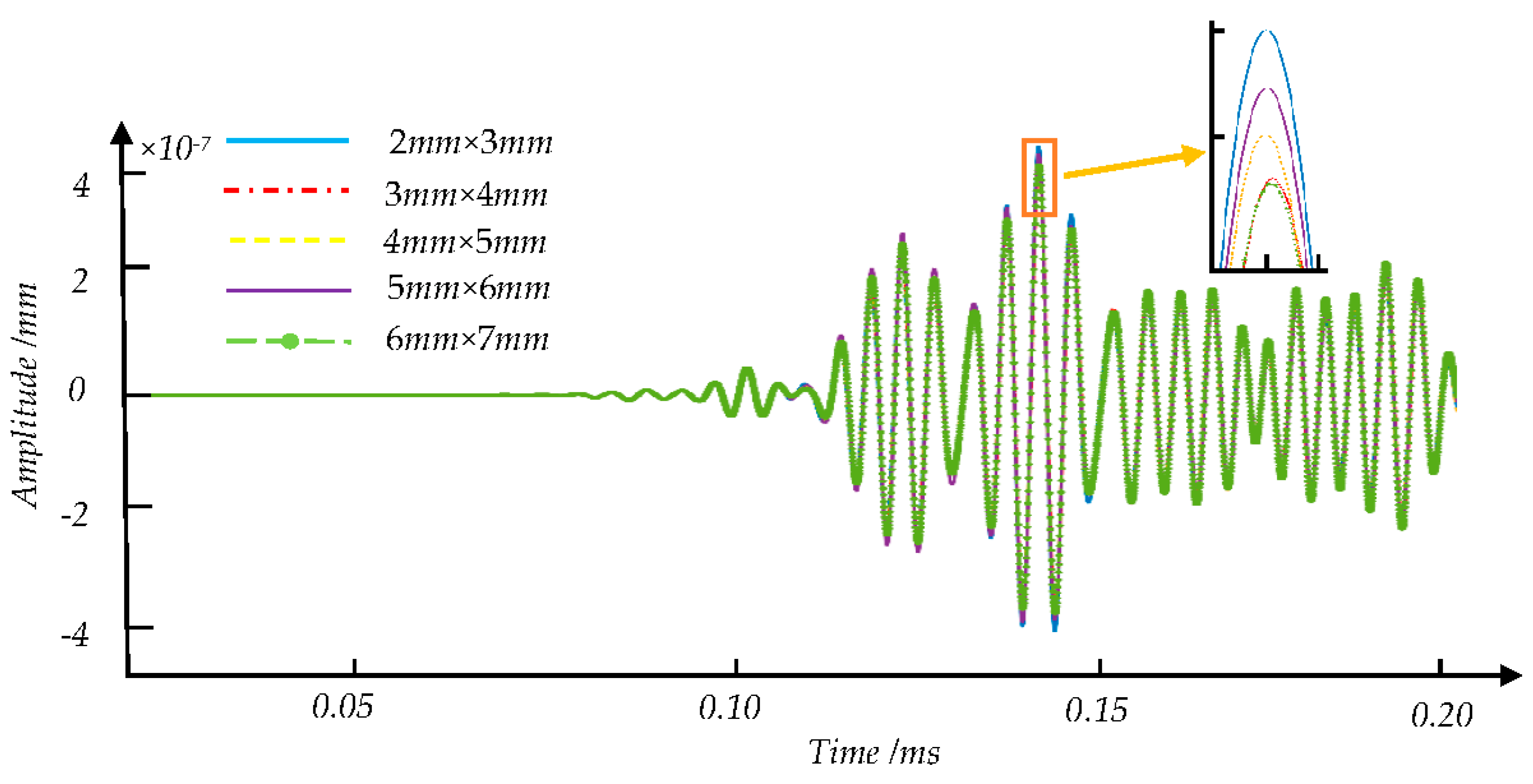
| Damage Degree | Number of Samples | Damage Degree | Number of Samples |
|---|---|---|---|
| intact | 10 | 4 mm | 10 |
| 1 mm | 10 | 5 mm | 10 |
| 2 mm | 10 | 6 mm | 10 |
| 3 mm | 10 | 7 mm | 10 |
| Model | Length | ρ | E | υ |
|---|---|---|---|---|
| 60 kg/m | 250 mm | 7.85 × 10−9 | 2 × 105 | 0.29 |
| Defection Type | Defection Category (mm) | Total Number of Samples | Actual Damage (mm) | Number of Samples |
|---|---|---|---|---|
| intact | intact | 10 | 0 | 10 |
| crack | 1 | 30 | 1.0 | 10 |
| 1.1 | 10 | |||
| 1.2 | 10 | |||
| 2 | 30 | 1.8 | 10 | |
| 1.9 | 10 | |||
| 2.0 | 10 | |||
| 3 | 10 | 3.0 | 10 | |
| 4 | 10 | 4.0 | 10 | |
| 5 | 10 | 5 | 10 | |
| 6 | 10 | 6 | 10 | |
| 7 | 28 | 6.9 | 6 | |
| 7 | 10 | |||
| 7.1 | 6 | |||
| 7.2 | 6 |
| Defection Type | Sample Label | Defection Category | Number of Samples | Total Number of Samples |
|---|---|---|---|---|
| intact | 1 | - | 20 | 403 |
| Crack defect | 2 | 1 mm | 40 | |
| 3 | 2 mm | 40 | ||
| 4 | 3 mm | 20 | ||
| 5 | 4 mm | 20 | ||
| 6 | 5 mm | 20 | ||
| 7 | 6 mm | 20 | ||
| 8 | 7 mm | 38 | ||
| Corrosion defect | 9 | 6 mm2 | 20 | |
| 10 | 12 mm2 | 20 | ||
| 11 | 25 mm2 | 20 | ||
| 12 | 30 mm2 | 20 | ||
| Internal nuclear defect | 13 | 2 mm × 3 mm | 21 | |
| 14 | 3 mm × 4 mm | 21 | ||
| 15 | 4 mm × 5 mm | 21 | ||
| 16 | 5 mm × 6 mm | 21 | ||
| 17 | 6 mm × 7 mm | 21 |
| N | L(mm) | Tc (μs) | Kp | P |
|---|---|---|---|---|
| 2 | 0.2 | 0.5 | 50 | 400 |
| 10 | 1.0 | 2.5 | 250 | 80 |
| 20 | 2.0 | 5.0 | 500 | 40 |
| 30 | 3.0 | 7.5 | 750 | 27 |
| 40 | 4.0 | 10.0 | 1000 | 20 |
| 50 | 5.0 | 12.5 | 1250 | 16 |
| 0.5 μs | 2.5 μs | 5.0 μs | 7.5 μs | 10.0 μs | 12.5 μs | |
|---|---|---|---|---|---|---|
| 1TA | 86.21 | 86.21 | 87.36 | 86.21 | 86.21 | 86.21 |
| 1TB | 94.25 | 95.40 | 95.40 | 90.80 | 91.95 | 90.80 |
| 1TC | 77.01 | 77.01 | 79.31 | 78.16 | 79.31 | 78.16 |
| 2TA | 94.25 | 95.40 | 95.40 | 95.40 | 95.40 | 93.10 |
| 2TB | 90.80 | 90.80 | 93.10 | 91.95 | 89.66 | 88.51 |
| 2TC | 88.51 | 88.51 | 88.51 | 89.66 | 89.66 | 88.51 |
| 3TA | 72.41 | 74.71 | 75.86 | 73.56 | 72.41 | 72.41 |
| 3TB | 89.66 | 89.66 | 90.80 | 89.66 | 89.66 | 88.51 |
| 3TC | 90.81 | 91.95 | 91.95 | 93.10 | 90.81 | 91.95 |
| 10% | 20% | 30% | 40% | 50% | 60% | 70% | 80% | 90% | 99% | |
|---|---|---|---|---|---|---|---|---|---|---|
| 1TA | 89.66 | 89.66 | 89.66 | 89.66 | 90.80 | 91.95 | 90.80 | 89.66 | 89.66 | 88.51 |
| 1TB | 88.51 | 88.51 | 88.51 | 88.51 | 94.25 | 94.25 | 89.66 | 90.80 | 88.51 | 87.36 |
| 1TC | 79.31 | 79.31 | 79.31 | 79.31 | 79.31 | 77.01 | 70.11 | 78.16 | 75.86 | 78.16 |
| 2TA | 95.40 | 95.40 | 95.40 | 95.40 | 96.55 | 93.10 | 94.25 | 93.10 | 94.25 | 90.80 |
| 2TB | 94.25 | 94.25 | 94.25 | 94.25 | 96.55 | 96.55 | 95.40 | 95.40 | 95.40 | 94.25 |
| 2TC | 90.80 | 90.80 | 90.80 | 90.80 | 90.80 | 88.51 | 88.51 | 88.51 | 88.51 | 83.91 |
| 3TA | 72.41 | 72.41 | 72.41 | 72.41 | 73.56 | 68.97 | 68.97 | 67.82 | 68.97 | 67.82 |
| 3TB | 81.61 | 81.61 | 81.61 | 81.61 | 89.66 | 94.25 | 91.95 | 87.36 | 83.91 | 87.36 |
| 3TC | 86.21 | 86.21 | 86.21 | 86.21 | 90.80 | 89.66 | 87.36 | 88.51 | 89.66 | 86.21 |
| 1 | 2 | 3 | 4 | 5 | 6 | 7 | 8 | 9 | 10 | 11 | 12 | 13 | 14 | 15 | 16 | 17 | |
|---|---|---|---|---|---|---|---|---|---|---|---|---|---|---|---|---|---|
| precision | 1.00 | 0.75 | 0.75 | 1.00 | 1.00 | 1.00 | 0.75 | 0.90 | 0.75 | 1.00 | 0.75 | 1.00 | 0 | 1.00 | 0.80 | 0.60 | 1.00 |
| recall | 1.00 | 0.67 | 0.75 | 1.00 | 1.00 | 1.00 | 1.00 | 0.90 | 0.75 | 0.80 | 1.00 | 1.00 | 0 | 1.00 | 0.80 | 0.50 | 0.71 |
| F1-score | 1.00 | 0.71 | 0.75 | 1.00 | 1.00 | 1.00 | 0.86 | 0.90 | 0.75 | 0.89 | 0.86 | 1.00 | - | 1.00 | 0.80 | 0.55 | 0.83 |
| 10% | 20% | 30% | 40% | 50% | 60% | 70% | 80% | 90% | 99% | |
|---|---|---|---|---|---|---|---|---|---|---|
| 1TA | 49.43 | 49.43 | 49.43 | 49.43 | 74.71 | 74.71 | 74.71 | 77.01 | 80.46 | 90.80 |
| 1TB | 42.53 | 42.53 | 42.53 | 63.22 | 63.22 | 63.22 | 73.56 | 73.56 | 85.06 | 94.25 |
| 1TC | 50.57 | 50.57 | 50.57 | 66.67 | 66.67 | 66.67 | 66.67 | 66.67 | 71.26 | 78.16 |
| 2TA | 54.02 | 54.02 | 54.02 | 75.86 | 75.86 | 75.86 | 83.91 | 89.66 | 89.66 | 96.55 |
| 2TB | 58.62 | 58.62 | 58.62 | 58.62 | 82.76 | 82.76 | 90.80 | 90.80 | 93.10 | 95.40 |
| 2TC | 48.28 | 48.28 | 48.28 | 48.28 | 73.56 | 73.56 | 73.56 | 83.91 | 89.66 | 88.51 |
| 3TA | 42.53 | 42.53 | 42.53 | 42.53 | 55.17 | 55.17 | 55.17 | 59.77 | 64.37 | 73.56 |
| 3TB | 58.62 | 58.62 | 58.62 | 58.62 | 81.61 | 81.61 | 81.61 | 85.06 | 87.36 | 94.25 |
| 3TC | 50.57 | 50.57 | 50.57 | 70.11 | 70.11 | 74.71 | 74.71 | 80.46 | 78.16 | 90.80 |
| Accuracy | S | Precision | Recall | F1-Score | |
|---|---|---|---|---|---|
| 1TA | 90.99% | 0.03 | 91.20% | 90.13% | 89.83% |
| 1TB | 90.22% | 0.02 | 91.95% | 90.07% | 90.19% |
| 1TC | 76.15% | 0.04 | 82.01% | 73.76% | 74.43% |
| 2TA | 93.63% | 0.02 | 94.12% | 93.54% | 93.32% |
| 2TB | 92.75% | 0.02 | 94.68% | 92.36% | 92.05% |
| 2TC | 90.11% | 0.03 | 90.79% | 89.26% | 89.06% |
| 3TA | 76.53% | 0.03 | 83.10% | 79.71% | 76.89% |
| 3TB | 90.77% | 0.02 | 91.80% | 90.26% | 90.29% |
| 3TC | 88.02% | 0.03 | 89.90% | 87.88% | 87.43% |
| Combination Type | Accuracy | S | Precision | Recall | F1-Score |
|---|---|---|---|---|---|
| 1TAB | 96.15% | 0.02 | 96.29% | 95.59% | 95.51% |
| 1TAC | 93.08% | 0.01 | 93.67% | 92.37% | 92.08% |
| 1TBC | 91.21% | 0.02 | 92.56% | 90.295 | 90.50% |
| 1TABC | 94.73% | 0.02 | 95.32% | 94.00% | 94.20% |
| 2TAB | 93.74% | 0.02 | 95.42% | 93.51% | 93.20% |
| 2TAC | 94.07% | 0.01 | 94.99% | 93.66% | 93.58% |
| 2TBC | 94.95% | 0.02 | 96.34% | 95.10% | 94.87% |
| 2TABC | 96.15% | 0.01 | 96.63% | 96.13% | 95.93% |
| 3TAB | 89.01% | 0.03 | 90.25% | 88.36% | 88.51% |
| 3TAC | 88.79% | 0.02 | 90.57% | 88.49% | 87.77% |
| 3TBC | 88.90% | 0.02 | 90.62% | 88.38% | 88.34% |
| 3TABC | 90.55% | 0.03 | 91.64% | 90.31% | 89.99% |
| Combination Type | Accuracy | S | Precision | Recall | F1-Score |
|---|---|---|---|---|---|
| 1TA + 2TA | 96.29% | 0.02 | 96.34% | 96.06% | 95.70% |
| 1TA + 3TA | 89.78% | 0.01 | 90.39% | 87.82% | 87.58% |
| 2TA + 3TA | 92.75% | 0.02 | 93.23% | 92.72% | 92.43% |
| 1TA + 2TA + 3TA | 95.49% | 0.02 | 96.12% | 95.20% | 95.03% |
| 1TB + 2TB | 95.38% | 0.01 | 96.32% | 95.35% | 94.94% |
| 1TB + 3TB | 93.08% | 0.02 | 94.54% | 92.35% | 92.59% |
| 2TB + 3TB | 94.03% | 0.02 | 95.31% | 94.71% | 94.10% |
| 1TB + 2TB + 3TB | 93.41% | 0.02 | 95.23% | 93.79% | 93.45% |
| 1TC + 2TC | 92.09% | 0.02 | 93.02% | 92.05% | 92.00% |
| 1TC + 3TC | 90.22% | 0.03 | 91.97% | 89.74% | 89.06% |
| 2TC + 3TC | 91.43% | 0.03 | 93.35% | 90.98% | 90.83% |
| 1TC + 2TC + 3TC | 92.09% | 0.03 | 93.44% | 92.22% | 91.95% |
Publisher’s Note: MDPI stays neutral with regard to jurisdictional claims in published maps and institutional affiliations. |
© 2021 by the authors. Licensee MDPI, Basel, Switzerland. This article is an open access article distributed under the terms and conditions of the Creative Commons Attribution (CC BY) license (https://creativecommons.org/licenses/by/4.0/).
Share and Cite
Deng, F.; Li, S.-Q.; Zhang, X.-R.; Zhao, L.; Huang, J.-B.; Zhou, C. An Intelligence Method for Recognizing Multiple Defects in Rail. Sensors 2021, 21, 8108. https://doi.org/10.3390/s21238108
Deng F, Li S-Q, Zhang X-R, Zhao L, Huang J-B, Zhou C. An Intelligence Method for Recognizing Multiple Defects in Rail. Sensors. 2021; 21(23):8108. https://doi.org/10.3390/s21238108
Chicago/Turabian StyleDeng, Fei, Shu-Qing Li, Xi-Ran Zhang, Lin Zhao, Ji-Bing Huang, and Cheng Zhou. 2021. "An Intelligence Method for Recognizing Multiple Defects in Rail" Sensors 21, no. 23: 8108. https://doi.org/10.3390/s21238108
APA StyleDeng, F., Li, S.-Q., Zhang, X.-R., Zhao, L., Huang, J.-B., & Zhou, C. (2021). An Intelligence Method for Recognizing Multiple Defects in Rail. Sensors, 21(23), 8108. https://doi.org/10.3390/s21238108





